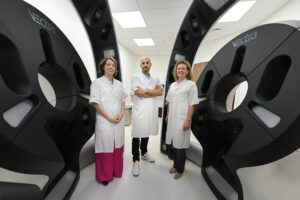What is skin cancer
Skin Cancer and Melanoma
There are many types of skin cancer, each with a distinct appearance. UV light (sunlight) affects the development of skin cancer, which is why skin cancer often occurs on the face, hands, arms, legs, and torso. Melanoma is an aggressive form of skin cancer that can metastasize. Approximately 12% of all skin cancers are melanomas. About 7,000 people are diagnosed with melanoma every year in the Netherlands, with most people being between 30 and 60 years old when they are diagnosed.
What is the life expectancy?
It is hard to make a general statement about this. Life expectancy strongly depends on the stage at which we detect melanoma. If we catch it early, start treatment promptly, and there are no metastases, the chances of recovery are high. Always have unusual skin pigmentations or spots on the skin or concerning moles checked by your general practitioner. They can refer you for further diagnostics at our Center.

Our friendly professionals work together on early diagnostics and scientific research. You may meet them at our Center.
Skin cancer is the most common form of cancer worldwide among people with a lighter skin type. It is a collective term for various types of skin cancers. Melanoma is an aggressive form of skin cancer. Melanoma can develop on healthy skin or from an existing mole. Melanoma can appear anywhere on the skin, including the scalp or the foot soles.
A skin pigmentation or mole with one or more of the following characteristics could be melanoma:
- Irregular edges: no smooth, clean border
- Odd shape, not symmetrical or round
- A mix of different colors (dark and light)
- Larger than 6 millimeters
- The pigmentation appeared suddenly, or an existing mole starts to change, itch, or grow
It can be. If melanoma occurs in your immediate family, you may want to have your moles checked thoroughly every year. We may recommend remaining under our Center’s care after your skin examination.
Definitely not. There are many types of skin cancer. Only about 12% of all skin cancers are melanomas.
No, skin examinations are not painful. At the NKI Center for Early Diagnostics, we use the latest equipment, the Vectra WB360. You will have to stand in front of the camera, and the device takes 92 3D images of your entire body. You will receive more clarity quickly based on these images and additional skin examinations by the dermatologist. Is melanoma present? We may want to remove a mole (under anesthesia) for further investigation.
Certainly, you can go elsewhere for skin examinations. However, we have the Vectra WB360: this allows us to take high-resolution 3D photos of the entire body within seconds. Globally, we are one of the few research centers using this state-of-the-art equipment. The technology increases the accuracy of examinations and follow-up assessments.
